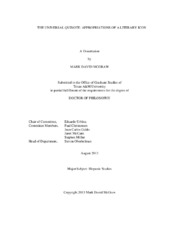| dc.description.abstract | First functioning as image based text and then as a widely illustrated book, the impact of the literary figure Don Quixote outgrew his textual limits to gain near-universal recognition as a cultural icon. Compared to the relatively small number of readers who have actually read both extensive volumes of Cervantes´ novel, an overwhelming percentage of people worldwide can identify an image of Don Quixote, especially if he is paired with his squire, Sancho Panza, and know something about the basic premise of the story. The problem that drives this paper is to determine how this Spanish 17^(th) century literary character was able to gain near-univeral iconic recognizability. The methods used to research this phenomenon were to examine the character´s literary beginnings and iconization through translation and adaptation, film, textual and popular iconography, as well commercial, nationalist, revolutionary and institutional appropriations and determine what factors made him so useful for appropriation.
The research concludes that the literary figure of Don Quixote has proven to be exceptionally receptive to readers´ appropriative requirements due to his paradoxical nature. The Quixote’s “cuerdo loco” or “wise fool” inherits paradoxy from Erasmus of Rotterdam’s In Praise of Folly. It is Don Quixote´s paradoxy that allows readers and viewers to choose the aspects of the protagonist that they find most useful. Some of that difference in interpretation has been diachronic, starting with a burlesque view of Don Quixote as the insane hidalgo, later developing a romantic interpretation of the protagonist as a noble knight. Much of that difference has been geographical, with Spanish appropriators tending to reflect Don Quixote as a heroic reflection of national character, and many outside of Spain choosing to use the knight as a symbol of impracticality and failure. Ultimately, Don Quixote´s long lasting influence has been due to his ability to embody the best of the human spirit; the desire to fashion oneself into a more noble identity and achieve greater deeds than one´s cultural environment would normally allow. | en |


